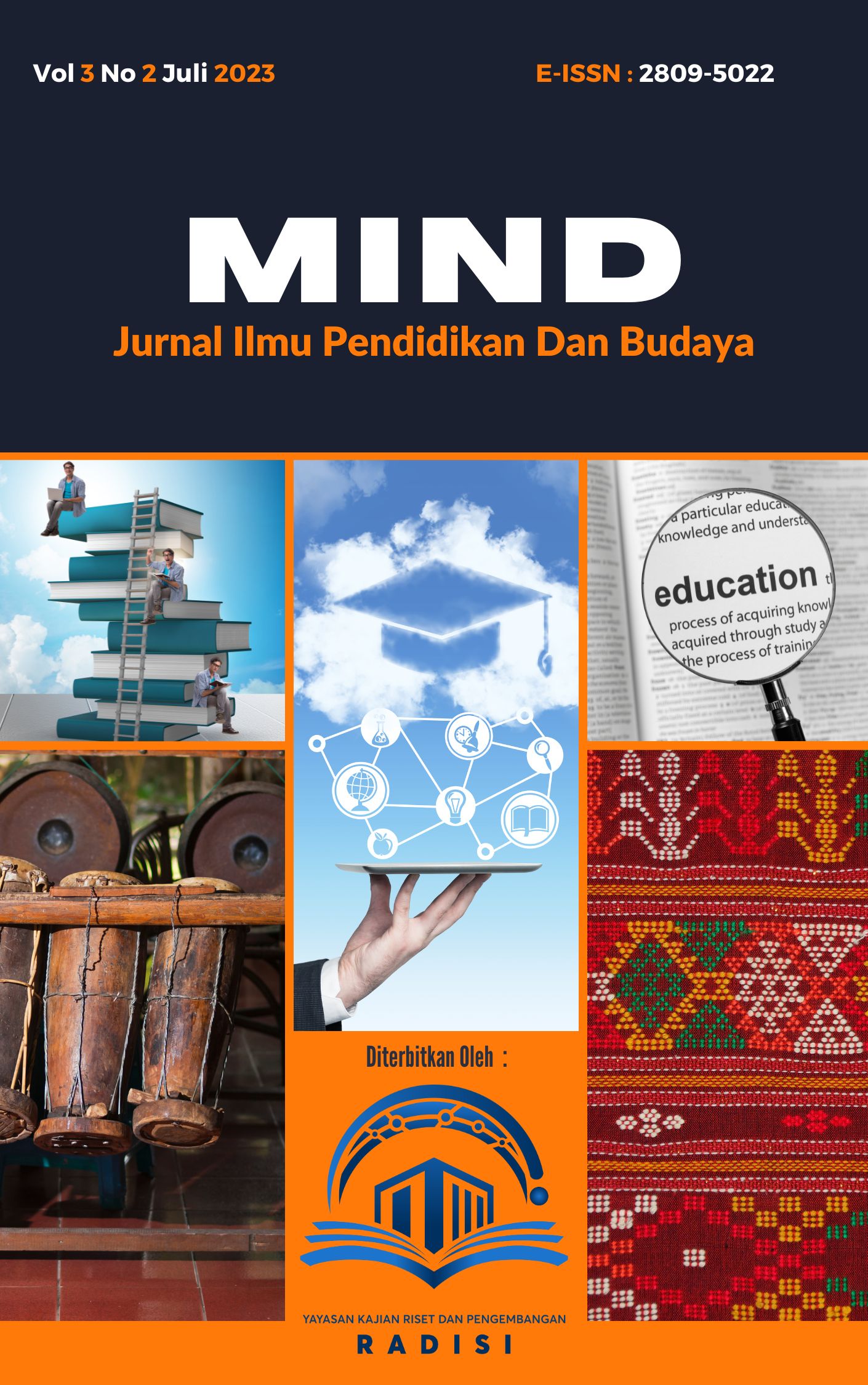Optimalisasi Pembelajaran IPS Terpadu Melalui Aktivitas Belajar Siswa dalam Meningkatkan Pemahaman Konsep dan Keterampilan Berpikir Kritis
DOI:
https://doi.org/10.55266/jurnalmind.v3i2.499Kata Kunci:
Pembelajaran berbasis aktivitas, Ilmu Pengetahuan Sosial, keterampilan berpikir kritis, hasil belajar, metode eksperimen semuAbstrak
Pembelajaran berbasis aktivitas semakin banyak digunakan untuk meningkatkan kualitas pendidikan, terutama dalam Ilmu Pengetahuan Sosial (IPS). Penelitian ini menganalisis efektivitas metode ini dalam meningkatkan pemahaman konsep dan keterampilan berpikir kritis siswa melalui eksperimen semu dengan desain pretest-posttest control group, melibatkan 80 siswa yang terbagi dalam kelompok eksperimen dan kontrol. Data dikumpulkan melalui pretest, posttest, observasi, dan angket. Hasil penelitian menunjukkan peningkatan signifikan dalam pemahaman konsep pada kelompok eksperimen dibandingkan kelompok kontrol (t = 4.12, p < 0.05). Siswa dalam kelompok eksperimen lebih aktif berdiskusi, berinteraksi, dan menunjukkan inisiatif lebih tinggi. Hasil angket mengonfirmasi bahwa mereka lebih termotivasi dan memahami materi lebih baik. Temuan ini mendukung teori konstruktivisme, yang menekankan pentingnya interaksi aktif dalam pembelajaran. Namun, kendala seperti keterbatasan waktu dan kesiapan siswa dalam belajar mandiri masih menjadi tantangan. Penelitian selanjutnya disarankan mengeksplorasi strategi pengelolaan waktu dan pemanfaatan teknologi untuk meningkatkan efektivitas metode ini.
Unduhan
Referensi
Ali, S. S. (2019). Problem-based learning: A student-centered approach. English Language Teaching, 12(5), 42-53. https://eric.ed.gov/?id=EJ1212283
Aytaç, T., & Kula, S. S. (2020). The effect of student-centered approaches on students' creative thinking skills: A meta-analysis study. International Journal of Contemporary Educational Research, 7(1), 108-121. https://dergipark.org.tr/en/pub/ijcer/issue/58098/723894
Bresler, L., & Stake, R. E. (2017). Qualitative research methodology in music education. Critical Essays in Music Education. https://doi.org/10.4324/9781315095257-8
Chusorn, P., Phosri, W., Somprach, K., & Kuntajai, U. (2014). Integrated learning teacher professional development in primary schools. Procedia - Social and Behavioral Sciences, 116, 1863-1868. https://doi.org/10.1016/j.sbspro.2014.01.493
Clarke, E., & Visser, J. (2019). Pragmatic research methodology in education: Possibilities and pitfalls. International Journal of Research & Method in Education, 42(3), 235-250. https://doi.org/10.1080/1743727X.2018.1524866
Daniel, B. K., & Harland, T. (2017). Higher education research methodology: A step-by-step guide to the research process. Taylor & Francis. https://doi.org/10.4324/9781315149783
Emaliana, I. (2017). Teacher-centered or student-centered learning approach to promote learning. Jurnal Sosial Humaniora, 10(2), 59-70. https://pdfs.semanticscholar.org/0227/363df587d020fba2dd57959e225560e3ea9a.pdf
Fleming, J., & Zegwaard, K. E. (2018). Methodologies, methods, and ethical considerations for conducting research in work-integrated learning. International Journal of Work-Integrated Learning, 19(3), 205-213. https://eric.ed.gov/?id=EJ1196755
Granda Vera, J., Rojas Ruiz, G., & Mingorance Estrada, Á. C. (2019). Flipped classroom to improve university student-centered learning and academic performance. Social Sciences, 8(11), 315. https://www.mdpi.com/2076-0760/8/11/315
Harland, T. (2014). Learning about case study methodology to research higher education. Higher Education Research & Development, 33(6), 1113-1122. https://doi.org/10.1080/07294360.2014.911253
Hoidn, S., & Reusser, K. (2020). Foundations of student-centered learning and teaching. Taylor & Francis. https://doi.org/10.4324/9780429259371-3
Jackson, D. (2015). Employability skill development in work-integrated learning: Barriers and best practice. Studies in Higher Education, 40(5), 761-780. https://doi.org/10.1080/03075079.2013.842221
Kaput, K. (2018). Evidence for student-centered learning. Education Evolving. https://eric.ed.gov/?id=ED581111
Kelly, A. E. (2016). Design research in education: Yes, but is it methodological? Design-Based Research, 24(4), 303-315. https://doi.org/10.4324/9780203764565-8
Newman, M., & Gough, D. (2020). Systematic reviews in educational research: Methodology, perspectives, and application. OAPEN Library. https://doi.org/10.1007/978-3-658-27602-7_3
Noon, E. J. (2018). Interpretive phenomenological analysis: An appropriate methodology for educational research? Journal of Perspectives in Applied Academic Practice, 6(1), 75-86. https://doi.org/10.14297/jpaap.v6i1.304
Salam, M., Awang Iskandar, D. N., Ibrahim, D. H. A., & Farooq, M. S. (2019). Service learning in higher education: A systematic literature review. Asia Pacific Education Review, 20(2), 573-588. https://doi.org/10.1007/S12564-019-09580-6
Serin, H. (2018). A comparison of teacher-centered and student-centered approaches in educational settings. International Journal of Social Sciences & Educational Studies, 5(1), 164-173. https://ijsses.tiu.edu.iq/index.php/ijsses/article/view/665
Sung, Y. T., Chang, K. E., & Liu, T. C. (2016). The effects of integrating mobile devices with teaching and learning on students' learning performance: A meta-analysis and research synthesis. Computers & Education, 94, 252-275. https://doi.org/10.1016/j.compedu.2015.11.008
Walters, R., Wills, G., & Aguti, B. (2014). Effective use of e-learning technologies to promote student-centered learning paradigms within higher education institutions. International Journal for e-Learning. https://eprints.soton.ac.uk/382471/1/Effective%2520Use%2520of%2520E%2520Learning%2520Technologies%2520to%2520Promote%2520Student%2520Centered%2520Learning.pdf
Xhomara, N. (2020). The effect of student-centered teaching and problem-based learning on academic achievement in science. Journal of Turkish Science Education, 17(4), 563-577. https://www.tused.org/index.php/tused/article/view/970
Unduhan
Diterbitkan
Cara Mengutip
Terbitan
Bagian
Lisensi
Hak Cipta (c) 2023 Nur Lisan, Siti Maryam Pane, Muhammad Yusuf Ritonga

Artikel ini berlisensiCreative Commons Attribution-NonCommercial-ShareAlike 4.0 International License.






